In today’s modern homes, maintaining optimal indoor air quality has become a priority for many. Amid various solutions to achieve this, humidifiers stand out as essential tools, especially in regions experiencing dry climates or during seasons when indoor heating can strip the air of its natural moisture. However, the effectiveness and longevity of these devices hinge not just on their design and operation but also on the quality of water used in them. This article delves into the significance of choosing the right type of water for your humidifier, with a special focus on the benefits of using distilled water. We’ll explore how distilled water compares to tap water in the context of humidifier use, its impact on the device’s maintenance, and ultimately, its influence on the air quality within your living spaces. Whether you’re a new humidifier owner or looking to optimize your current setup, understanding the role of water quality in humidification will empower you to make informed decisions for a healthier, more comfortable home environment.
Why You Need the Best Humidifier in Your Home for 2024
Excessive dryness in your home can lead to a myriad of issues, from irritated skin and dry throats to worsening symptoms of asthma and allergies. This is particularly true during the winter months when heating systems can strip indoor air of its natural moisture, making it uncomfortable to live in and potentially damaging wooden furniture and musical instruments. Moreover, maintaining optimal humidity levels can help reduce the spread of flu viruses, which thrive in low humidity environments. Humidifiers play a crucial role in adding necessary moisture back into your air, making your home more comfortable and healthy.
However, with the vast array of humidifiers on the market, it can be challenging to choose the right one for your needs. Before investing in a humidifier, consider the size of the space you need to humidify, the type of humidifier that best suits your needs (e.g., ultrasonic, evaporative), whether you prefer a warm or cool mist, and any additional features such as smart controls or air purifying capabilities.
Additionally, budget is an important consideration, as humidifier prices can range significantly based on their features and capacity. Whether you’re looking for a simple unit for a small bedroom or a more sophisticated system for your entire home, there’s a humidifier designed to meet your specific needs and budget.
Do you have to use distilled water in a humidifier?
No, you don’t have to use distilled water in a humidifier, but it is recommended to reduce mineral buildup and white dust, and to minimize the risk of bacteria and mold growth. Tap water can be used, especially in evaporative humidifiers, but distilled water is generally better for maintaining the device and improving air quality.
The Quick List: Top Picks for 2024
Before we dive into detailed reviews, here’s a quick look at our top picks for the best humidifiers you can buy right now:
- LEVOIT LV600HH 6L Warm and Cool Mist Ultrasonic Humidifier – Best Overall
- Pure Enrichment® MistAire™ Ultrasonic Cool Mist Humidifier – Best for Small Spaces
- Canopy Humidifier – Best for Bedrooms
- LEVOIT Humidifiers for Large Rooms – Best for Large Spaces
- Vicks Filter-Free Ultrasonic Humidifier – Best for Cold and Flu Relief
- SHARP Air Purifier And Humidifier – Best 2-in-1 Option
- Dreo 6L Humidifiers – Best for Ease of Use
- Homedics Ultrasonic Humidifier – Best for Features
- Vornado UH200 Ultrasonic Humidifier – Best for Quiet Operation
- LEVOIT OasisMist 1000S Smart Humidifier – Best Smart Humidifier
Best Humidifiers for 2024: Your Guide to Comfortable Living
With new models and technologies constantly emerging, we’ve done extensive research to bring you the best humidifiers for every space, lifestyle, and budget for 2024. Whether you’re dealing with dry air in a large living space or seeking a compact solution for your bedroom, our comprehensive guide covers the top choices to help you find the perfect match for your home.
LEVOIT LV600HH 6L Warm and Cool Mist Ultrasonic Humidifier
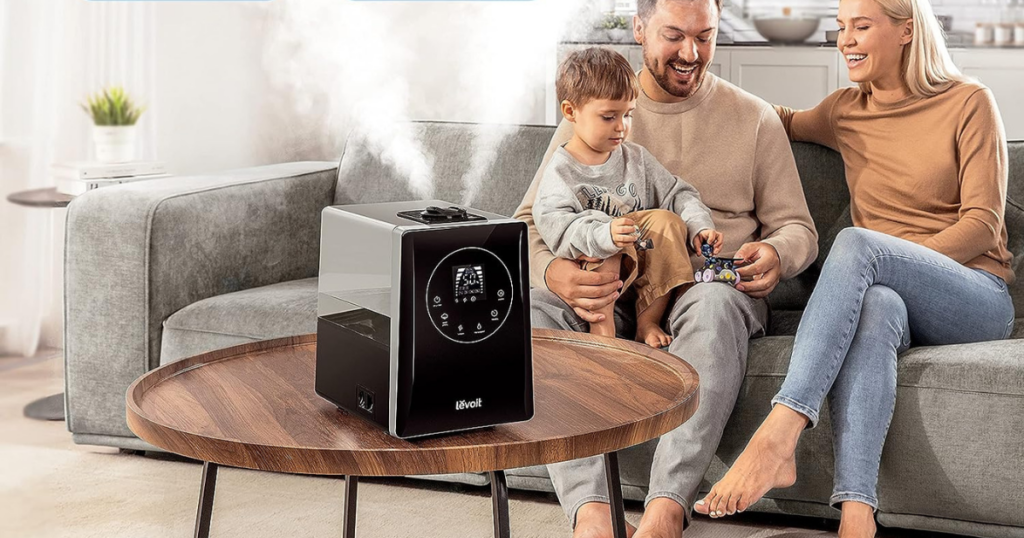
(Image Credit: LEVOIT)
Overview: The LEVOIT LV600HH stands out with its hybrid functionality, offering both warm and cool mist to cater to varying environmental needs and personal preferences. Its ultrasonic technology ensures operation is whisper-quiet, making it an ideal companion in bedrooms, nurseries, or any space where noise is a concern. The 6-liter capacity means it can humidify large rooms up to 753 sq ft, making it perfect for open-concept living spaces or large bedrooms.
PROS
- Versatility: Warm mist for cold winters and cool mist for hot summers.
- Extended Run Time: Up to 36 hours of continuous operation on a single fill.
- Quiet Operation: Ultrasonic technology reduces noise to a near-silent level.
- Remote Control and Humidity Level Control: Offers convenience and allows for precise humidity management.
- Aroma Box: Adds the ability to use essential oils, providing both humidity and a pleasant aroma.
CONS
- Price Point: Its advanced features and capacity come at a higher cost.
- Maintenance: Regular cleaning is required to prevent mold growth and mineral deposit build-up, particularly when using warm mist.
TODAY’S BEST DEAL
Ideal For: This humidifier is ideal for users looking for a versatile, high-capacity unit that can handle large spaces with ease. It’s particularly suited for those who experience drastic seasonal changes and value the health benefits of maintaining optimal humidity levels year-round.
Pure Enrichment® MistAire™ Ultrasonic Cool Mist Humidifier

(Image Credit: Pure)
Overview: The Pure Enrichment® MistAire™ Ultrasonic Cool Mist Humidifier is designed for simplicity and efficiency. Its 1.5-liter water tank provides up to 16 hours of continuous operation, making it perfect for overnight use in bedrooms or nurseries. The sleek, minimalist design not only blends seamlessly into any decor but also occupies minimal space, making it ideal for small to medium-sized rooms.
PROS
- Compact and Efficient: Small footprint with effective humidification for personal spaces.
- Whisper-Quiet Operation: Ultrasonic technology ensures a quiet environment for sleep or work.
- Automatic Shut-Off: Enhances safety by turning off when the water level is low.
- Adjustable Mist Control: Allows for easy adjustment of mist output to suit personal preferences.
CONS
- Limited Coverage: Best suited for smaller spaces and may not be effective in large rooms.
- No Warm Mist Option: Only provides cool mist, which might not be sufficient for colder climates.
TODAY’S BEST DEAL
Ideal For: Ideal for users in need of a compact, straightforward humidifier for personal use, such as in bedrooms, offices, or small living areas. It’s especially suitable for those living in milder climates or seeking relief from dry air in specific rooms.
Canopy Humidifier
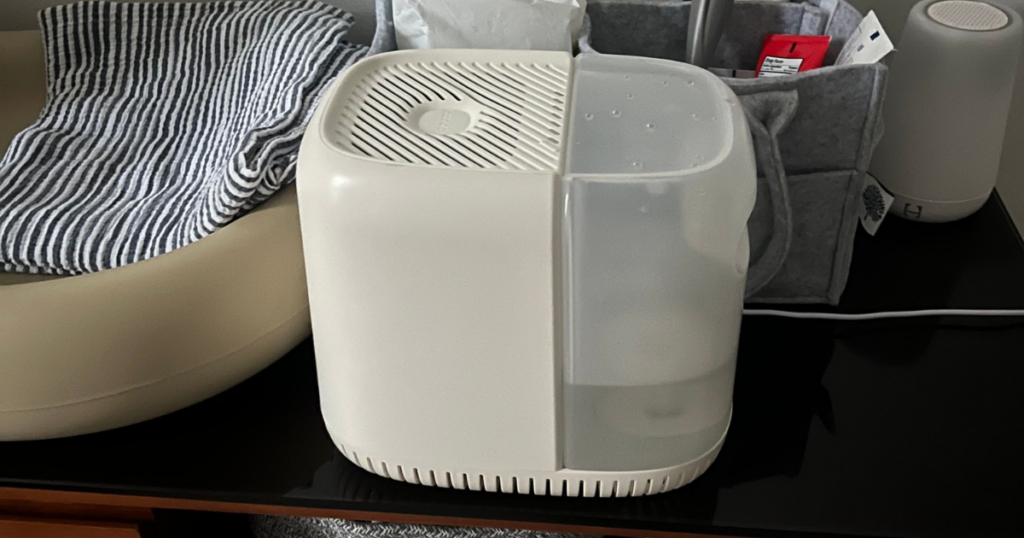
(Image Credit: Canopy)
Overview: The Canopy Humidifier is designed with a focus on health and hygiene, featuring an anti-mold technology that ensures the water vapor released is clean and beneficial. Its 2.5L capacity and up to 36-hour runtime make it suitable for continuous use in bedrooms and medium-sized living spaces. The no-mist evaporative technology means it moisturizes the air without leaving surfaces damp, making it ideal for use around electronics and wooden furniture.
PROS
- Anti-Mold Technology: Keeps the water tank clean and mold-free.
- No Mist Evaporative Output: Moisturizes air without wetting surfaces.
- Dishwasher Safe Parts: Easy cleaning and maintenance.
- Auto Mode: Adjusts output to maintain optimal humidity levels automatically.
CONS
- Price Point: It’s on the higher end of the price spectrum for its category.
- Limited to Cool Mist: May not be as effective in colder climates where warm mist is preferable.
TODAY’S BEST DEAL
Ideal For: Best suited for health-conscious individuals and families looking for a low-maintenance, hygienic humidifier for medium-sized rooms. Its anti-mold feature is particularly appealing for those with allergies or respiratory sensitivities.
LEVOIT Humidifiers for Bedroom Large Room Home
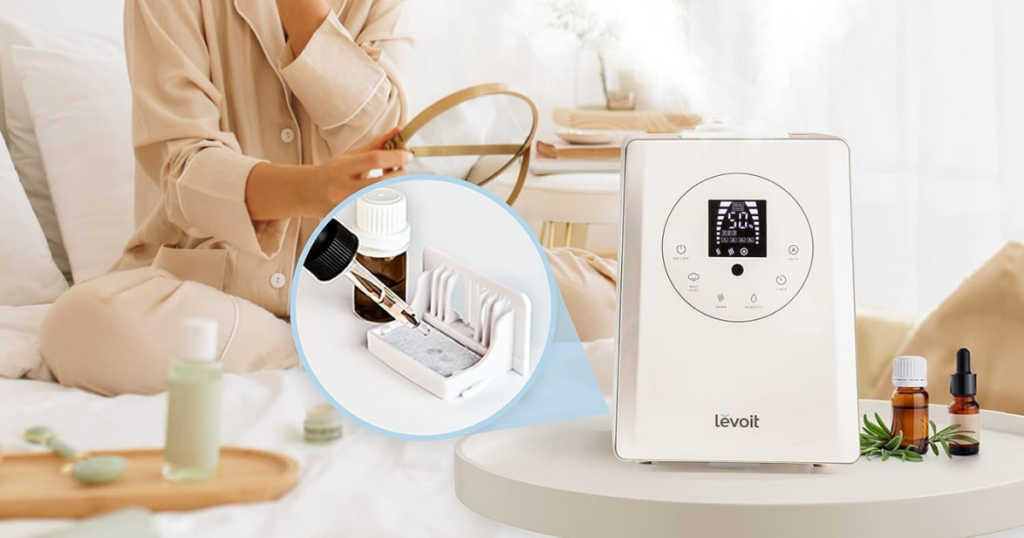
(Image Credit: LEVOIT)
Overview: The LEVOIT Humidifier for Bedroom Large Room Home offers a generous 6L capacity and dual warm and cool mist functionality, catering to a broad range of humidity needs. Designed for large rooms, it can easily humidify spaces up to 753 sq ft. The unit boasts a quiet operation and a user-friendly touch control panel, along with a remote control for convenience.
PROS
- Dual Mist Technology: Offers both warm and cool mist options.
- Large Capacity: Suitable for long hours of operation without needing a refill.
- Quiet Operation: Ensures minimal disturbance during sleep or daily activities.
- Remote Control: Enhances ease of use and convenience.
CONS
- Maintenance: Requires regular cleaning to maintain optimal performance and hygiene.
- Initial Cost: The upfront investment may be higher compared to simpler models.
TODAY’S BEST DEAL
Ideal For: This humidifier is perfect for users needing a versatile and efficient solution for large spaces. Its dual mist functionality makes it adaptable to different seasonal needs, making it an excellent choice for family homes, large bedrooms, or offices.
Vicks Filter-Free Ultrasonic Humidifier
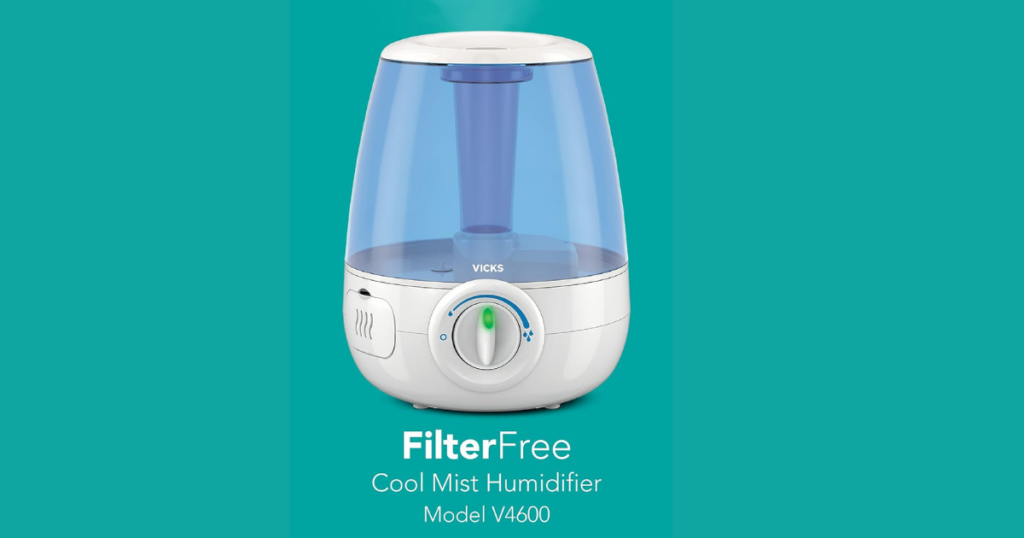
(Image Credit: Vicks)
Overview: The Vicks Filter-Free Ultrasonic Humidifier is designed for ease of use and convenience, offering cool mist humidification without the need for replacement filters. Its 1.2-gallon tank provides up to 30 hours of moisture, ideal for medium-sized rooms. The unit also features a Vicks VapoPad slot, allowing users to add soothing menthol vapors for enhanced comfort during cold and flu season.
PROS
- Filter-Free Operation: Lowers ongoing costs and maintenance.
- Vicks VapoPad Slot: Offers the option to use soothing Vicks vapors.
- Easy to Clean: Designed with simplicity in mind for hassle-free maintenance.
- Quiet Operation: Suitable for bedrooms to promote a restful night’s sleep.
CONS
- Cool Mist Only: May not be as effective in very cold environments.
- Limited Advanced Features: Lacks some of the more sophisticated controls found in higher-end models.
TODAY’S BEST DEAL
Ideal For: Great for individuals and families looking for a simple, effective humidifier to ease respiratory discomfort, especially during cold and flu season. It’s particularly beneficial for those who appreciate the added comfort of Vicks vapors.
SHARP Air Purifier And Humidifier
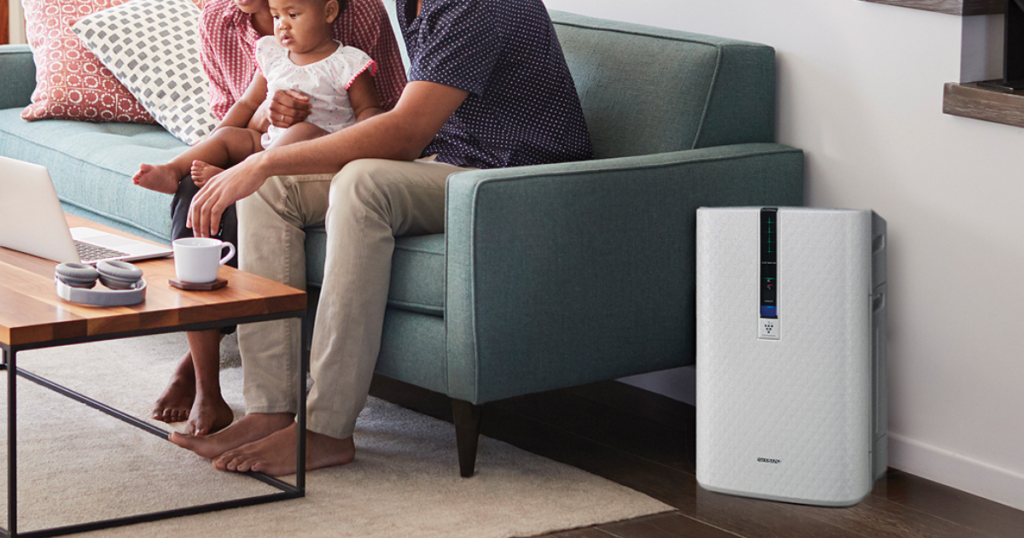
(Image Credit: SHARP)
Overview: Combining the benefits of air purification with humidification, the SHARP Air Purifier and Humidifier is a versatile unit designed for enhancing indoor air quality. It features Plasmacluster Ion technology to actively clean the air of pollutants and allergens, while its humidification function maintains comfortable moisture levels. Suitable for medium to large rooms, this device is an all-in-one solution for health-conscious individuals.
PROS
- Air Purification: Removes allergens, viruses, and pollutants.
- Plasmacluster Ion Technology: Actively reduces microbial growth in the air.
- Dual Functionality: Offers both humidification and air purification.
- Automatic Operation: Adjusts settings based on the room’s current air quality and humidity levels.
CONS
- Price: Higher investment due to its dual functionality.
- Size and Weight: Larger and heavier than standard humidifiers, requiring more space.
TODAY’S BEST DEAL
Ideal For: Ideal for users looking for a comprehensive solution to indoor air quality issues. It’s especially suitable for those with allergies, asthma, or pets, providing both air purification and humidification to create a healthier living environment.
Understanding Humidifiers: What Readers Need to Know
Types of Humidifiers:
- Ultrasonic Humidifiers: Use ultrasonic vibrations to produce mist. They are known for quiet operation, making them ideal for bedrooms and offices.
- Evaporative Humidifiers: Blow air over a wet wick or filter to evaporate water into the air. They are self-regulating, as the humidity level affects the evaporation rate.
- Steam Vaporizers: Heat water to create steam, which cools before leaving the machine. They can be more hygienic due to the boiling process but are hotter and potentially hazardous around children.
- Impeller Humidifiers: Use a rotating disk to fling water at a diffuser, breaking the water into fine droplets that are released into the air. They are generally quieter and safer for use around children.
Benefits of Using a Humidifier:
- Health: Prevents dryness in the nose, throat, and skin, which can reduce irritation, chapping, and soreness.
- Comfort: Maintains a comfortable level of humidity, especially in colder months when heating systems can dry out indoor air.
- Preservation: Helps preserve the integrity of wood furniture, floors, and musical instruments by maintaining optimal humidity levels.
- Plant Health: Benefits indoor plants by preventing the leaves from becoming dry and brittle.
Features to Consider:
- Tank Size: Determines how long the humidifier can run before needing a refill. Larger tanks are suited for longer run times and larger spaces.
- Humidistat: Allows for automatic regulation of the room’s humidity level, ensuring it stays within a healthy and comfortable range.
- Maintenance and Cleaning: Some models require more frequent cleaning or filter changes. Understanding the maintenance requirements can help in selecting a more convenient option.
- Noise Level: Especially important in bedrooms or quiet environments. Ultrasonic humidifiers are typically the quietest.
- Safety Features: Auto shut-off when the water level is low and cool-mist options are safer for use around children and pets.
Maintenance Tips:
- Regular cleaning is crucial to prevent mold and bacteria growth. Follow the manufacturer’s instructions for cleaning practices.
- Use distilled or demineralized water in ultrasonic and impeller humidifiers to minimize mineral buildup and white dust.
- Replace filters as recommended for evaporative humidifiers to maintain efficiency and air quality.
Selecting the Right Humidifier:
- Consider the size of the space where the humidifier will be used. Larger rooms may require humidifiers with higher output or larger tanks.
- Reflect on specific needs such as noise sensitivity, desire for easy maintenance, or additional features like aromatherapy capabilities.
- Evaluate the climate and environment. In colder areas, a warm mist option might be more beneficial, while in milder climates, a cool mist could suffice.
Humidifier Buyer’s Guide
Understanding the Basics
Why You Need a Humidifier: Humidifiers add moisture to the air, combating the dryness that can occur in many environments, particularly during winter when heaters are in use. Proper humidity levels can help with dry skin, irritations, allergies, and overall comfort.
Types of Humidifiers
- Ultrasonic: These use a vibrating diaphragm to create a fine mist. Available in cool or warm mist versions, they’re quiet and efficient.
- Evaporative: Air blows through a moistened filter, evaporating water into the air. These are self-regulating since the air can only hold a certain amount of moisture.
- Steam Vaporizers: Electrically heated to create steam, which cools before exiting the unit. They can be less expensive but hotter to the touch.
- Impeller: Water is flung at a diffuser by a rotating disk, breaking it into fine droplets. These are typically child-friendly, offering cool mist without the risk of burns.
Key Features to Consider
- Tank Capacity: Determines how long the unit can run between refills. Larger rooms or longer use times require bigger tanks.
- Humidistat: To maintain a desired humidity level automatically, ensuring comfort without over-humidification, which can encourage mold growth.
- Ease of Maintenance: Some models require more cleaning and maintenance than others. Consider how easy it is to clean the unit and whether it has parts that need regular replacement.
- Noise Level: Important for bedrooms or quiet environments. Ultrasonic models are typically the quietest.
- Safety Features: Especially for homes with children or pets. Features like auto shut-off when empty and cool mist options enhance safety.
- Additional Features: Such as built-in hygrometers, night lights, essential oil trays for aromatherapy, and remote controls for convenience.
Maintenance and Care
Regular cleaning is essential to prevent mold and bacteria buildup. Use distilled or demineralized water in ultrasonic and impeller humidifiers to minimize mineral deposits. Follow the manufacturer’s instructions for cleaning and maintenance, and replace filters as necessary.
Matching the Humidifier to Your Needs
- Room Size: Match the humidifier’s output capacity to the size of the space. Larger spaces may require more powerful units or multiple humidifiers.
- Health and Comfort: Consider any health issues, such as allergies or respiratory conditions, that may benefit from specific types of humidifiers.
- Climate: Those in colder climates might prefer warm mist humidifiers, while those in warmer areas might opt for cool mist options.
Budget Considerations
Prices can vary widely based on size, type, and features. Determine your budget beforehand but consider operating and maintenance costs, such as filter replacements, as part of the total investment.
FAQ on Humidifiers
1. What is the ideal indoor humidity level?
The ideal indoor humidity level is between 30% and 50%. This range helps ensure comfort, protects household items from damage, and can help reduce the risk of respiratory infections and allergies.
2. Can humidifiers help with allergies?
Yes, humidifiers can help with allergies by maintaining optimal humidity levels. Proper humidity can soothe irritated nasal passages and throats, making it easier to breathe and reducing allergy symptoms.
3. How often should I clean my humidifier?
You should clean your humidifier at least once a week, but more frequent cleaning may be necessary depending on usage and water quality. Regular cleaning prevents the growth of mold and bacteria.
4. Can I use tap water in my humidifier?
While you can use tap water in most humidifiers, it’s often recommended to use distilled or demineralized water, especially in ultrasonic and impeller humidifiers. This reduces mineral buildup and the emission of white dust.
5. What’s the difference between cool mist and warm mist humidifiers?
Cool mist humidifiers emit a cool vapor into the air and are generally safer around children since there’s no risk of burns. Warm mist humidifiers heat water to produce steam, which can help kill germs and viruses but may pose a burn risk.
6. Do humidifiers use a lot of electricity?
The amount of electricity a humidifier uses depends on its size and type. Ultrasonic humidifiers are generally more energy-efficient compared to steam vaporizers. Always check the product specifications for power consumption details.
7. Can a humidifier cause mold in my house?
If a humidifier is not properly maintained or if the humidity level is set too high, it can contribute to mold growth. Using a humidistat to maintain humidity levels between 30% and 50% can help prevent mold.
8. How do I know if I need a humidifier?
Signs you may need a humidifier include dry skin, irritated eyes, dry throat or airways, frequent coughing, static electricity, and peeling wallpaper or cracking paint. A hygrometer can measure your home’s humidity levels to confirm.
In conclusion, understanding the importance of maintaining optimal indoor humidity levels is essential for ensuring the comfort, health, and well-being of everyone in your household. Humidifiers play a crucial role in achieving this balance, especially in environments where air can become excessively dry due to heating in the winter or air conditioning in the summer. With a variety of types available, including ultrasonic, evaporative, steam vaporizers, and impeller humidifiers, there’s a solution for every need and preference.
The key to selecting the right humidifier lies in understanding the size of the space you need to humidify, the specific benefits of different humidifier types, and the features that best meet your needs. Considerations such as tank capacity, ease of maintenance, noise level, and additional features like humidistats and aromatherapy options can greatly influence your satisfaction with a humidifier.
Regular maintenance and the use of distilled or demineralized water where recommended can extend the life of your humidifier and ensure it operates safely and effectively. By addressing common questions and concerns through a comprehensive FAQ section, we aim to empower consumers to make informed decisions that enhance their indoor air quality and overall quality of life.
Incorporating a humidifier into your home can alleviate discomfort from dry air, protect wooden furniture and musical instruments from damage, and even reduce susceptibility to infections by maintaining mucous membrane health. Whether you’re dealing with allergies, looking to improve sleep quality, or simply wanting to create a more comfortable living environment, the right humidifier can make all the difference.
Remember, the goal is to achieve a balanced humidity level that supports your health and comfort without encouraging the growth of mold and mildew. With the insights provided in this guide, you’re well-equipped to find the humidifier that best fits your lifestyle and to use it effectively for maximum benefit.